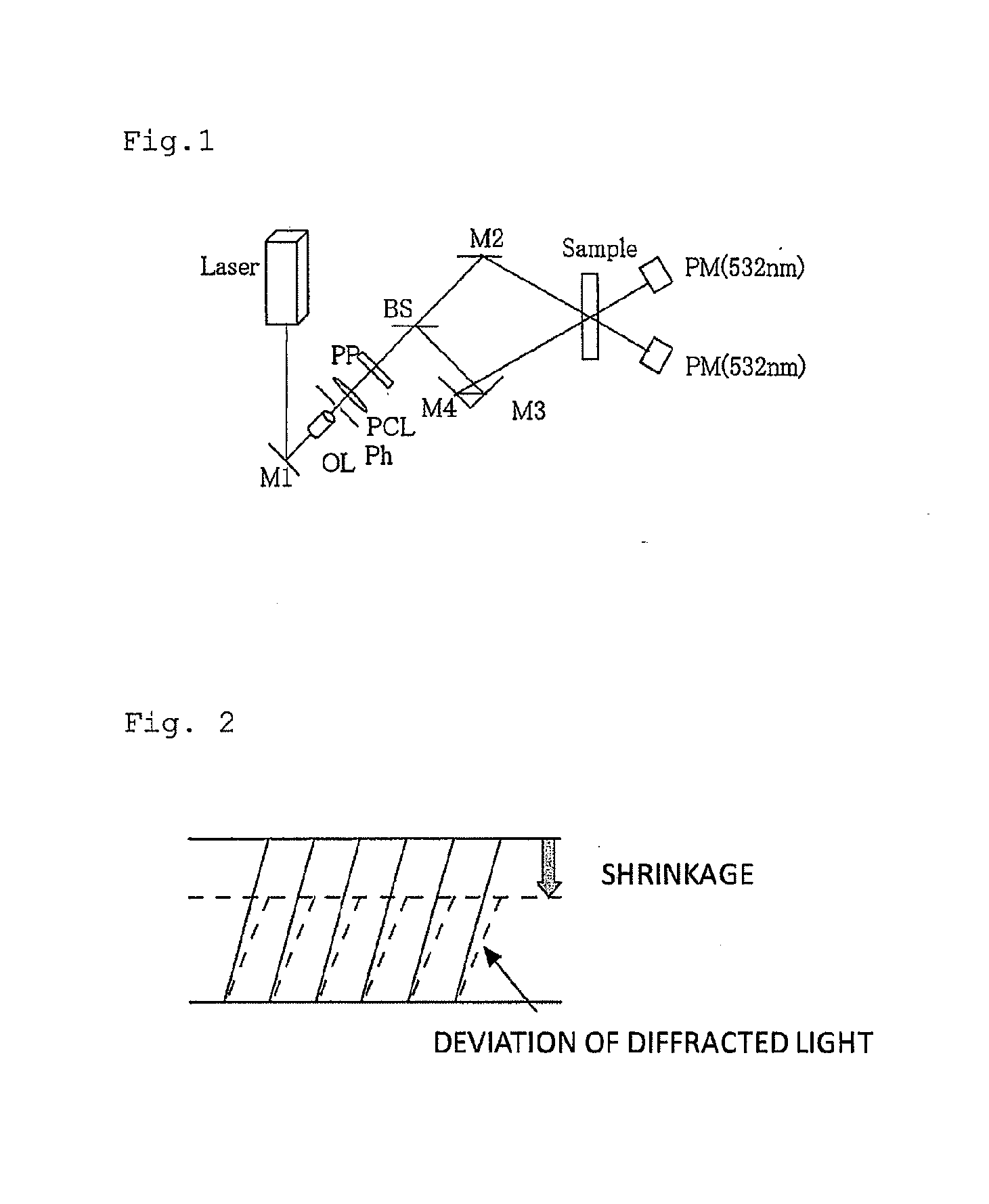Photosensitive composition for volume hologram recording and producing method thereof
a technology of photosensitive composition and volume hologram, which is applied in the direction of photomechanical equipment, instruments, holographic processes, etc., can solve the problems of limiting the application of photosensitive composition to optical elements and storage devices requiring dimensional stability, holographic photosensitive composition, and significant shrinkage of holographic photosensitive composition, etc., to achieve high polymerization reactivity, small volume shrinkage, and superior refractive index modulability
- Summary
- Abstract
- Description
- Claims
- Application Information
AI Technical Summary
Benefits of technology
Problems solved by technology
Method used
Image
Examples
examples
[0105]The present invention will be illustrated in further detail with reference to several working examples below. It should be noted, however, that these examples are never construed to limit the scope of the present invention.
[0106](Optical System)
[0107]FIG. 1 shows a schematic diagram of the optical system used in the following experiments. A light source used herein was 532-nm semiconductor laser, and laser beams emitted therefrom passed through a mirror (M), spatial filters (OL and Ph), a planoconvex lens (PCL), and a phase plate (retardation plate) (PP) and were split into two beams by a beam splitter (BS). The two beams split by the BS were applied via mirrors to the sample at angles of 30 degrees and 30 degrees, respectively, and thereby interfered. The intensities of the diffracted light and transmitted light were respectively determined with power meters (PM: supplied by ADC Corporation).
[0108]The diffraction efficiency and shrinkage percentage were determined by the foll...
example x-1
[0113]A photosensitive composition X-1 was prepared by dissolving 60 parts by weight of a poly-2-vinylnaphthalene (Mw=93,000) as a binder polymer (A), 100 parts by weight of a cationically polymerizable compound (B), 10 parts by weight of diphenyliodonium compound (trade name “PI 2074” supplied by Rhodia) as a photoinitiator (C), and 0.5 part by weight of a coumarin dye (trade name “NKX 1658” supplied by Hayashibara Biochemical Laboratories, Inc.) as a sensitizing dye (D) in 30 parts by weight of cyclohexanone. The cationically polymerizable compound (B) was a 7:1 (by mole) mixture of a bifunctional alicyclic epoxy compound (3,4,3′,4′-diepoxybicyclohexyl) and a bifunctional vinyl ether compound (oxynorbornene divinyl ether). The photosensitive composition X-1 was dropped onto a glass substrate, spread thereon with an applicator so as to give a layer with a thickness of 25 μm, and a PET film having a thickness of 50 μm was placed in a frame form on the peripheral surface of the glass...
example x-2
[0114]A photosensitive composition X-2 was prepared by dissolving 70 parts by weight of a poly-2-vinylnaphthalene (Mw=93,000) as a binder polymer (A), 100 parts by weight of a cationically polymerizable compound (B), 10 parts by weight of a diphenyliodonium compound (trade name “PI 2074” supplied by Rhodia) as a photoinitiator (C), and 0.5 part by weight of a coumarin dye (trade name “NKX 1658” supplied by Hayashibara Biochemical Laboratories, Inc.) as a sensitizing dye (D) in 280 parts by weight of cyclohexanone. The cationically polymerizable compound (B) was a 7:1 (by mole) mixture of a bifunctional alicyclic epoxy compound (3,4,3′,4′-diepoxybicyclohexyl) and a bifunctional vinyl ether compound (oxynorbornene divinyl ether). A hologram recording medium X-2 (having a thickness of the holographic material layer of 25 μm) was prepared by the procedure of Example X-1, except for dropping the photosensitive composition X-2 onto a glass substrate, spreading thereon using an applicator ...
PUM
| Property | Measurement | Unit |
|---|---|---|
| refractive indices | aaaaa | aaaaa |
| volume shrinkage | aaaaa | aaaaa |
| thickness | aaaaa | aaaaa |
Abstract
Description
Claims
Application Information
 Login to View More
Login to View More - R&D
- Intellectual Property
- Life Sciences
- Materials
- Tech Scout
- Unparalleled Data Quality
- Higher Quality Content
- 60% Fewer Hallucinations
Browse by: Latest US Patents, China's latest patents, Technical Efficacy Thesaurus, Application Domain, Technology Topic, Popular Technical Reports.
© 2025 PatSnap. All rights reserved.Legal|Privacy policy|Modern Slavery Act Transparency Statement|Sitemap|About US| Contact US: help@patsnap.com

